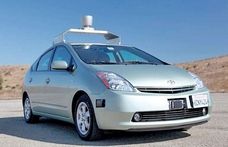It’s been a while since I posted anything regarding the transportation industry. There’s a lot to catch up upon from over the summer and I’ll try not to inundate you too quickly but there’s a great deal of information to share with you in this dynamic arena. But let me start with the following article that was on page 3 of this week’s Automotive News.
It is becoming clear that this is no ordinary time in the industry. Changes are occurring at a rapid pace. Many of the initiatives that are being pursued by the Sierra Club’s Transportation and Building A Better Community campaigns are taking root in significant ways and are reflected in this article. These changes will lead to more and safer transportation options such as walking, biking and public transportation. This in turn will also push Transportation Oriented Development (TOD) more rapidly. All this will mean less driving. Combined with higher fuel economy and conversion of the auto fleet to EV’s, oil consumption will drop along with the commensurate level of CO2 emissions.
The tipping point is coming as a sea change in transportation evolves.
‘Smarter’ cars still looking for direction
Gabe Nelson Google Plus RSS feed
Automotive News
September 6, 2014 – 12:01 am ET
SAN FRANCISCO — Over the past half century, the principal drivers of change in the automobile industry were safety, fuel efficiency and environmental imperatives. Yet none of these engines was potent enough to challenge the industry’s basic business model.
The next epoch could be different.
The car of the future, as it’s being developed today, is a rolling Internet hot spot, a node on a vast network of vehicles, a high-speed mobile computer capable of analyzing its surroundings in a blink and making precise, split-second decisions in response. It would devote itself to moving swiftly and safely amid traffic and hazards.
It would do all things a driver could but better, even if that means taking control of the wheel and the pedals itself.
But while the technology zooms toward this ideal of an efficient, orderly flow of “smart” vehicles across intersections, cities and continents — much of this wizardry will be on display at this coming week’s World Congress on Intelligent Transport Systems in Detroit — the basic business of personal transportation is entering a period of profound uncertainty.
Yes, cars are becoming safer and more intelligent by the model year. But just how these intelligent conveyances will come to interact with one another, and their human operators, remains unclear. So are the answers to such basic questions as who will build these cars, who will sell them, who will control them, and whether anyone will need them.
Fundamental challenges
Just the past year or two have seen developments that challenge some basic assumptions underpinning the auto business. Today, it’s Google, not an automaker or supplier, that’s leading the movement toward fully self-driving cars. Tesla Motors’ cars are being serviced not at a dealership garage but through software updates pushed wirelessly, straight from the cloud.
Suppliers that spent decades carving out niches or bulking up now find themselves fending off competitors from Silicon Valley and the telecom industry.
Companies such as Uber and Lyft are deploying smartphone apps in ways that may obviate taxicabs and even personally owned autos while the regulatory apparatus plays catch-up.
Meanwhile, that 19th-century marvel — the bicycle — is reasserting itself through bike-sharing services in such cities as New York and Washington, D.C., and even at General Motors’ engineering campus outside Detroit.
In short, the auto industry faces a set of trends and movements that could be more bewildering, and more threatening to the status quo, than any other change in the history of the automobile.
Order to the chaos
That dynamic, too, will be showcased at this week’s conference, as industry executives, government officials and researchers converge on Detroit in an effort to bring order out of chaos. For starters, they will seek to crystallize the role of the modern automobile in relation to its surroundings and its users.
Some of that soul-searching is already under way, judging by what Ford Motor Co. Executive Chairman Bill Ford wrote in an op-ed published in The Wall Street Journal in July.
“No matter how clean and efficient vehicles are, we simply cannot depend on selling more of them as they function today,” wrote Ford, who is scheduled to address the ITS conference Monday in Detroit.
“Cars will need to be smarter and more integrated into the overall transportation system. Forward-looking companies will redefine themselves and move from being just car and truck manufacturers to become personal-mobility companies.”
It was a surprising perspective coming from the scion of Henry Ford, whose Model T made car ownership a reality for the masses and set the auto industry on a centurylong quest to sell ever more cars to more people.
But it’s that idea of mobility that may ultimately serve as a guiding principle for the industry’s next phase. It’s the principle that has led automakers such as BMW and Daimler to look beyond their core business and invest in car-sharing.
Daimler app acquisition
Last week Daimler announced that it had acquired Mytaxi and RideScout, which enable people to hail a cab from their smartphone or plan a trip with a combination of walking, driving, public transportation and ride-sharing.
“Our aim is to make mobility as simple as possible,” Robert Henrich, the CEO of the Daimler subsidiary Moovel, said in a statement on the acquisition.
Also last week, the University of Michigan’s Mobility Transformation Center — there’s that word “mobility” again — announced that more than a dozen companies, including Ford, GM, Honda, Nissan, Toyota, Denso, Bosch and Verizon, have agreed to chip in $1 million apiece for a research program on the possibility of a future with shared autonomous cars taking the place of today’s ownership-based business model.
“We’ve decided that we want to address what we think the endpoint could be,” Peter Sweatman, director of the program, said in an interview last week. “There might be another endpoint, but I think we’ve chosen a very challenging one with a vision of where this might be going.”
Companies don’t usually invest in research or ideas that might upend their own business model, but these are, after all, unusual times.
You can reach Gabe Nelson at gnelson@crain.com.



